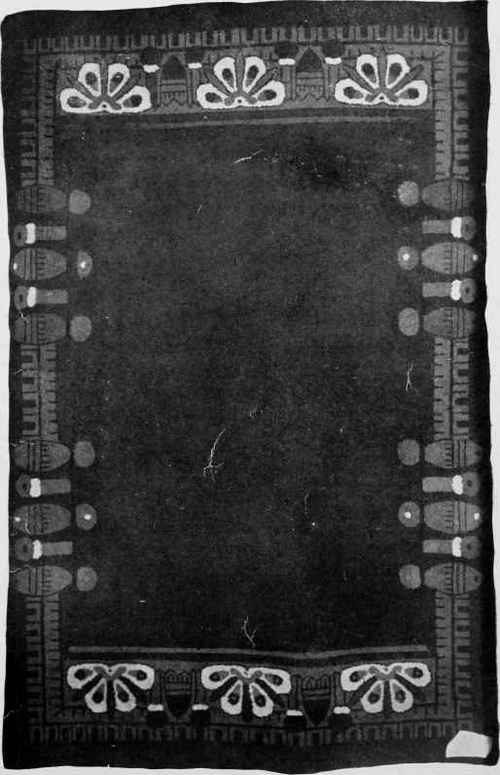Chapter XVIII. Pulled Rugs
Description
This section is from the book "Handicrafts In The Home", by Mabel Tuke Priestman. Also available from Amazon: Handicrafts in the Home.
Chapter XVIII. Pulled Rugs
Pulled rugs that are made by craft-workers to-day bear little resemblance to the hideous pulled rugs of previous generations. In olden days, the cat, dog, and cow vied with each other for supremacy for ornamenting these ugly but durable floor coverings. To-day, however, they are made with broad masses of colour and a simple arrangement of line and form, making effective and artistic rugs. Indian, Mexican, Japanese, and Oriental motifs are all utilized for these rugs, and every now and then glorious masses of colour worked out in savage ornament delight the eye, particularly of those found among the Pacific Islanders, or the Navajo Indians.
Pulled rugs are made of various materials, each group of workers having special reasons for the materials they use. The Abnakee rugs are made of all-wool unbleached flannel 11 twill, which is afterwards dyed the desired shade. These are among the most beautiful and durable of the rugs, their weight and beauty of colour making them a valued possession which will last a lifetime.
The Sabatos rug is another form of pulled rug, and is made of native wool homespun yarn, giving opportunity to women in isolated regions, not only to make the rugs, but to weave the material from which they are made. The sheep are raised by the farmers, and their wives weave the material and dye the wool for the craft-workers who make the rugs. The foundation of the Sabatos rug is woven in a hand-loom from pure wool. It is then fastened securely into a wooden frame, and short pieces of the vegetable-dyed yarn are drawn through and separately knotted like those made in the Orient. This knotting of the yarn increases the durability of the rugs, but renders the making of them slow and laborious.
Rugs made of flannel are pulled through a good quality of burlap, making a raised surface, which, combined with beautiful colouring and a good design, makes a serviceable and artistic rug.

Abnakee Rug. Egyptian Motie.
The Hook
The necessaries for making pulled rugs are not many, the material, the frame, and the hook being the only requisites. The best hook is about 5 inches long, and can be made out of a 40-penny nail about a quarter of an inch thick, filed and smoothed into shape at the end, and is given a slight curve which enables the user to hold the hook horizontally and yet allows the point to pierce the burlap vertically. These hooks, with the frame, can be supplied by dealers who sell burlap patterns for the hooked rugs. The patterns sold by dealers are extremely garish, however, and are only used by country people who have not yet been influenced by the late development in this industry.
The Frame
It is best to use a light adjustable frame. It should be made of soft wood consisting of four pieces, two of them 2 inches wide and 1 inch thick and 4 feet long, with a row of half-inch auger holes bored equal distances about 3 inches apart down the centre of each piece, at either end. The two crosspieces should be 17 inches long, with a fixed peg an inch and a half from each end. The strips for the holes can then be adjusted to suit the size of the rug. Any carpenter could make such a frame. An unadjustable one can be made of any old frame about the house, or even the frame for an artist's canvas could be utilized.
The Material
If flannel is to be used to make the rug, a soft wool flannel weighing about 3 3/4 ounces to the yard should be provided. As wool flannel cannot generally be obtained in suitable colourings, it is best to get them in white and dye them the required shade.
The Cutting
After the material is dyed, it is cut into straight narrow strips an inch and a quarter in width and the length of the material. It is best to have each strip about a yard in length. By folding a yard in four, the scissors will only have to go over the length of a quarter of a yard. The strips must be evenly and neatly cut, the distances being marked on paper which is laid underneath the flannel. A piece of elastic with a nail at either end of the cloth will ensure the cutting of a straight strip if the cutter-out has not a straight eye.
Continue to:


